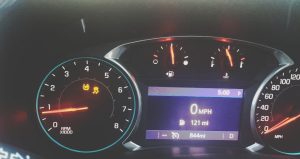If you’re like most people, you probably don’t think about your car’s traction control system very often. But if you own a Chevy Traverse, you might want to start paying closer attention to it.
Recent reports have surfaced that there may be a problem with the traction control system on the Traverse. Apparently, the system can sometimes turn itself off without the driver knowing it. This can obviously lead to some dangerous situations on the road.
So if you own a Traverse, be sure to keep an eye on your traction control system. And if you see Chevy traverse it turn itself off, be sure to take it to a dealer or mechanic right away. In the meantime, drive safely!
Contents
Chevy Traverse: Why You Should Keep the Traction Control On
Assuming you have a properly functioning traction control system, there are few reasons to ever turn it off. The main one is if you get stuck in mud or snow and need to spin the tires to get free. Other than that, there are very few circumstances in which you should need to turn it off.
The Chevy Traverse comes with an advanced traction control system that can help you maintain control on slippery roads. It does this by applying the brakes to individual wheels that start to slip. This helps redistribute power to the wheels that still have traction.
If you turn the traction control off, you lose this important safety feature. In some cases, you might also find that the Traverse performs worse without traction control because it can’t make up for your mistakes as easily.
So unless you’re stuck in mud or snow, we recommend keeping the traction control on at all times. That way, you can take advantage of the Traverse’s excellent handling and safety features on slippery roads.
The Benefits of Traction Control
Traction control is an important safety feature that helps drivers maintain control of their vehicles on slippery or uneven roads. By reducing wheel slip and distributing power to all four wheels, the traction control can help prevent skids and spinouts. For these reasons, traction control is standard equipment on most new vehicles.
How Traction Control Works
Chevy Traverse Traction Control off is a device that prevents the wheels from spinning on slippery surfaces by reducing power to the wheels. It does this by sensing when one or both of the drive wheels are spinning faster than the other and then reduces engine power to the wheel or wheels that are spinning. This action transfers power to the other wheel that has better traction.
Traction Control is most effective when it is used in conjunction with Anti-lock Brakes and Stability Control. When these three systems work together, they are often referred to as ESC or Electronic Stability Control.
The Different Types of Traction Control Systems
Vehicle traction control systems have come a long way since they were first introduced in the late 1980s. Today, there are several different types of traction control systems (TCS) available, each with its own advantages. Here is a brief overview of the most common types of TCS:
- Electronic Stability Control (ESC): ESC is an electronic system that helps to stabilize a vehicle when it senses that it is beginning to lose traction. It does this by automatically applying the brakes to individual wheels and reducing engine power if necessary. ESC is standard on all new vehicles sold in the United States as of 2012.
- Traction Control System (TCS): TCS is similar to ESC in that it helps to keep a vehicle stable when it detects that traction is lost. However, TCS functions by reducing engine power rather than applying the brakes. TCS is often found on vehicles with manual transmissions, as it can help to prevent wheel spin when starting from a stop or accelerating quickly.
- Active Yaw Control (AYC): AYC is a type of ESC that specifically targets a vehicle’s yaw motion or the tendency for a vehicle to rotate around its vertical axis. AYC uses braking and/or engine power reduction to keep a vehicle stable when cornering at high speeds or driving on uneven surfaces. AYC is often found on high-performance vehicles or those designed for off-road use.
- Vehicle Dynamics Control (VDC): VDC is another type of ESC that integrates several different stability control functions, including yaw control, understeer control, and rollover prevention. VDC systems are designed for use on vehicles with four-wheel drive (4WD) or all-wheel drive (AWD).
- Brake-Based Traction Control System (BTCS): BTCS uses the vehicle’s brakes to help maintain traction when starting from a stop or accelerating quickly. BTCS systems are typically found on older vehicles or those without ABS brakes.
When to Use Traction Control
Most drivers never have to think about traction control. It’s one of those modern automotive technologies that’s designed to be invisible, working in the background to keep you safe. But there are times when you might want to know how to turn off traction control.
First, a quick refresher on what traction control is and what it does. Traction control is a system that’s designed to prevent wheels from slipping and losing traction. It does this by reducing engine power or selectively applying the brakes to individual wheels.

Most modern vehicles have traction control, and it’s generally considered a good thing. But there are some situations when you might want to turn it off. One common reason is if you’re stuck in snow or mud and need to get moving again. With the traction control system turned off, you can give the wheels more power so they can spin and find some grip.
Another reason you might want to turn off traction control is if you’re driving on a loose surface like gravel or sand. In these conditions, the traction control system can actually make it harder for you to keep moving forward because it’s constantly trying to keep the wheels from slipping. If you turn it off, you can better maintain Control Of your vehicle on these surfaces.
Keep in mind that turning off traction control completely disables the system, so use caution when driving without it. Many newer vehicles also have a “traction control Off” warning light that illuminates when the system is disabled pay attention to this light and don’t forget to re-enable traction control when you no longer need it turned off.
How to Use Traction Control
Keeping your vehicle safe in slippery conditions means knowing how to use traction control. This system is designed to help your vehicle maintain traction on the road, preventing it from slipping and losing control. Here’s a quick guide on how to use traction control to keep you and your vehicle safe.
Tips for Maintaining Your Traction Control System
Chevy Traction Control System is an important safety feature in your Chevy car, truck, or SUV. When the roads are slippery, it can help you keep control of your vehicle by automatically narrowing the power output to the wheels that need it most. You can turn your traction control system on and off with a switch on the center console. If you decide to turn it off, here are some tips for maintaining your traction control system:
- Check your owner’s manual for specific instructions on how to properly operate your particular model’s traction control system.
- Be sure to turn the traction control system back on when you no longer need it.
- If you have trouble with your traction control system, take your vehicle to a certified Chevy dealer for diagnosis and repair.
Troubleshooting Traction Control Problems
If your Chevy Traverse is having traction control issues, there are a few things you can do to troubleshoot the problem. First, check to see if the Traction Control light is illuminated on the instrument panel. If it is, that means the system has been disabled. You can reenable it by pressing the button on the end of the turn signal lever.
If the light is not illuminated, there may be a problem with the sensors or the control module itself. Try cleaning the sensors with brake cleaner and a clean cloth. If that doesn’t work, you may need to replace the sensors. The control module is located under the hood, so if you suspect it may be faulty, you’ll need to take it to a mechanic or dealership for diagnosis and repair.
FAQs
Q: When Should You Use Traction Control?
A: Traction control should be used in any situation where the road surface is slippery or loose, such as when it’s raining, snowing, or there’s ice on the road. The system can also be used when driving on a gravel road or any other type of unpaved surface.
Q: How Does Traction Control Work?
A: Traction control works by sensing when one of your tires is beginning to slip and then applying the brakes to that tire. This helps transfer power from the slipping tire to the other tires that have better traction. In some cases, the system will also reduce engine power to help prevent tire spinning.
Q: How Do You Turn on the Traction Control?
A: In most vehicles, traction control is turned on automatically every time you start the engine. However, there may be a button or switch that you need to activate in order for the system to work. Consult your vehicle’s owner’s manual for more information.
Q: How Do You Know if Traction Control Is Working?
A: Most vehicles have a warning light that comes on whenever the traction control system is active. This light usually looks like a car with squiggly lines underneath it. If you see this light come on while you’re driving, it means that the system is working as intended.

